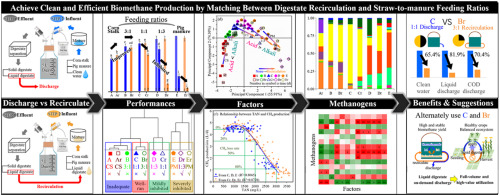Journal of Cleaner Production ( IF 11.1 ) Pub Date : 2020-04-02 , DOI: 10.1016/j.jclepro.2020.121414 Zehui Zheng , Yafan Cai , Yubin Zhao , Xingyao Meng , Yue Zhang , Chungui Lu , Yuegao Hu , Zongjun Cui , Xiaofen Wang

|
Liquid digestate recirculation can fundamentally solve the problem of voluminous liquid digestate discharge for biogas projects. However, the uncertainty of the effect of recirculation under different feedstock restricts the application of recirculation technology. In this study, the comprehensive effects of straw to manure feeding ratios and liquid digestate recirculation on anaerobic digestion performance and microbial community structure were investigated. Recirculation was beneficial for biomethane production and digestion stability in digesters of corn stalk and straw/manure 3:1 by alleviating the loss of ammonia and alkalinity, while it aggravated the accumulation of ammonia and organic acids and reduced methane yield under 1:1, 1:3 and pig manure. The feeding ratios and recirculation formed a combined effect on ammonia concentration in the fermentation system, and when the total ammonia concentration was above 1,500 mg/L, acids accumulation and decline in methane production would occur whether with recirculation or not. The microbial community structure varied corresponding to the fermentation state. In the well-run digesters, which were 3:1 with recirculation and 1:1 without recirculation, the dominant methanogens were Methanosaeta, while in the inhibited digesters, Methanosarcina and Methanosphaera dominated the methanogen community. Based on producing 1 GJ energy, the strategy of 3:1 with recirculation reduced the discharge of liquid digestate by 81.9% and the use of clean water by 65.4% compared to that of 1:1 without recirculation. An integrated approach of adjusting feedstock formula and selectively employing liquid digestate recirculation was proposed to produce liquid digestate on-demand with downstream application requirement, which will make biogas industry eco-friendly and cost-effective.
中文翻译:

通过匹配消化液再循环和秸秆与粪肥的进料比例,实现清洁高效的生物甲烷生产
液体消化物的再循环可以从根本上解决沼气项目中大量液体消化物排放的问题。然而,在不同原料下再循环效果的不确定性限制了再循环技术的应用。在这项研究中,研究了秸秆与粪肥的投料比和液体消化物再循环对厌氧消化性能和微生物群落结构的综合影响。在1:1、1的情况下,再循环可减轻氨气和碱度的流失,有利于玉米秸秆和秸秆/粪便3:1沼气池中生物甲烷的产生和消化稳定性,同时加重氨气和有机酸的积累并降低甲烷的产量(1:1、1) :3和猪粪。进料比和再循环对发酵系统中的氨浓度形成综合影响,当总氨浓度高于1,500 mg / L时,无论是否进行再循环,都会发生酸积累和甲烷产量下降。微生物群落结构随发酵状态而变化。在运行良好的消化器中,有3:1的再循环和1:1的无再循环的甲烷,主要的产甲烷菌是甲烷菌,而在受抑制的消化器中,甲烷菌和甲烷菌主导着甲烷菌群落。与没有再循环的1:1相比,基于产生1 GJ能量,采用3:1再循环的策略可将消化液的排放量减少81.9%,将净水的使用减少65.4%。


























 京公网安备 11010802027423号
京公网安备 11010802027423号